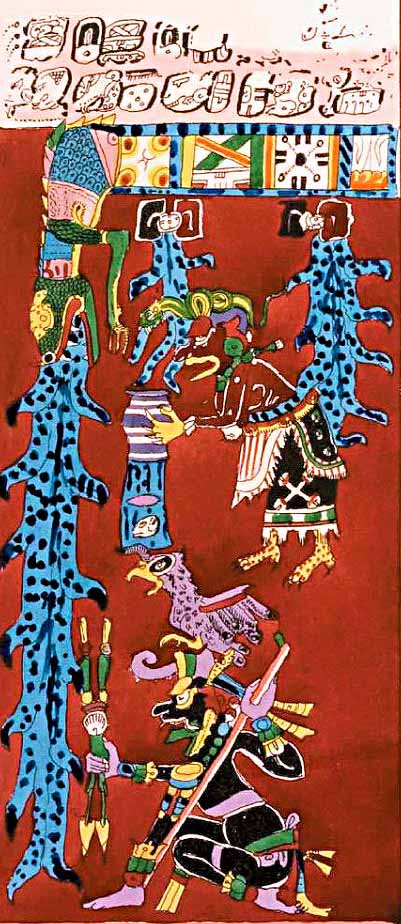

The Dresden Codex (a.k.a. Codex Dresdensis) is a pre-Columbian Maya book of the eleventh or twelfth century of the Yucatecan Maya in Chichen Itza. The Maya codex is believed to be a copy of an original text of some three or four hundred years earlier. Historians say it is the earliest known book written in the Americas.
The Dresden Codex is considered the most complete of the four remaining American codices. The names of the codices indicate where they were kept originally. The Dresden Codex is made from Amatl paper (fig-bark that has been flattened and covered with a lime paste), doubled in folds in an accordion-like form of folding-screen texts. The codex of bark paper is coated with fine stucco or gesso and is eight inches high by eleven feet long.
The Dresden Codex was written by eight different scribes using both sides. They all had their own particular writing style, glyphs and subject matter. The codex totals 74 pages in length. Its images were painted with extraordinary clarity using very fine brushes. The basic colors used from vegetable dyes for the codex were red, black and the so-called Mayan blue.
The Dresden Codex contains astronomical tables of outstanding accuracy. It is most famous for its Lunar Series and Venus table. The lunar series has intervals correlating with eclipses. The Venus Table correlates with the apparent movements of the planet. Contained in the codex are almanacs, astronomical and astrological tables, and religious references. The specific numen references have to do with a 260 day ritual count divided up in several ways. The Dresden Codex contains predictions for agriculturally-favorable timing. It has information on rainy seasons, floods, illness and medicine. It also seems to show conjunctions of constellations, planets and the Moon.
Johann Christian Gotze, Director of the Royal Library at Dresden, purchased the codex from a private owner in Vienna in 1739. How it got to Vienna is unknown. It is speculated that it was sent by Hernán Cortés as a tribute to King Charles I of Spain in 1519. Charles had appointed Cortes governor and captain general of the newly conquered Mexican territory. It has been in Europe ever since. Gotze gave it to the state library of Saxony, the Royal Library in Dresden, in 1744. The library first published the codex in 1848.
The library that held the codex was bombed and suffered serious damage during World War II. The Dresden Codex was heavily water damaged during the firebombing of Dresden. Twelve pages of the codex were harmed and other parts of the codex were destroyed. The codex was meticulously restored after this damage. According to historian Salvador Toscano, it is still a faithful representation of the precocity and elegance of the ancient Maya in spite of its restoration from severe damage.
In 2009, a History Channel presentation of "Decoding the Past", discussed the last page of the Dresden Codex. If you understand the metaphors, you will get the messages.

"The last page of the Dresden Codex shows the destruction of the world via water. Waves gush from the mouth of a celestial dragon. More flood waters pour from sun and moon symbols on the underside of the monster's body. An aged goddess also pours flood water onto the Earth. At the bottom of the picture crouches a ruler of the underworld. Above the picture, about half of the 15 glyphs have been destroyed, but a few of the remaining ones consistently refer to "Black Earth" or "Black on High"."